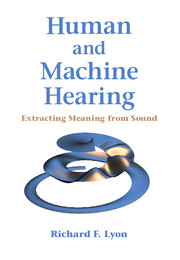Book contents
- Frontmatter
- Dedication
- Contents
- Foreword
- Preface
- Part I Sound Analysis and Representation Overview
- Part II Systems Theory for Hearing
- Part III The Auditory Periphery
- 13 Auditory Filter Models
- 14 Modeling the Cochlea
- 15 The CARFAC Digital Cochlear Model
- 16 The Cascade of Asymmetric Resonators
- 17 The Outer Hair Cell
- 18 The Inner Hair Cell
- 19 The AGC Loop Filter
- Part IV The Auditory Nervous System
- Part V Learning and Applications
- Bibliography
- Author Index
- Subject Index
- Plate section
14 - Modeling the Cochlea
from Part III - The Auditory Periphery
Published online by Cambridge University Press: 28 April 2017
- Frontmatter
- Dedication
- Contents
- Foreword
- Preface
- Part I Sound Analysis and Representation Overview
- Part II Systems Theory for Hearing
- Part III The Auditory Periphery
- 13 Auditory Filter Models
- 14 Modeling the Cochlea
- 15 The CARFAC Digital Cochlear Model
- 16 The Cascade of Asymmetric Resonators
- 17 The Outer Hair Cell
- 18 The Inner Hair Cell
- 19 The AGC Loop Filter
- Part IV The Auditory Nervous System
- Part V Learning and Applications
- Bibliography
- Author Index
- Subject Index
- Plate section
Summary
… the assumption of a ‘passive’ cochlea, where elements are brought into mechanical oscillation solely by means of the incident sound, is not tenable. The degree of resonance of the elements of the cochlea can be measured, and the results are not compatible with the very heavy damping which must arise from the viscosity of the liquid. For this reason the ‘regeneration hypothesis’ is put forward, and it is suggested that an electromechanical action takes place whereby a supply of electrical energy is employed to counteract the damping.
—“The physical basis of the action of the cochlea,” Thomas Gold (1948)The cochlea is the ear's sound filtering and amplification system, consisting primarily of two fluid-filled channels, the membrane that separates them, and the tiny organ of Corti that sits along the edge of the membrane to amplify and detect motion.
How can we describe and replicate what the cochlea does? By models—especially by models that have a structure derived from the underlying physics and that have been validated against a range of measurements on real human and animal auditory systems. Models that are based on distributed linear system theory, plus appropriate nonlinearities, describe the cochlea well, and lead to efficient algorithms or machines that can replicate the cochlea's sound analysis function.
The system theory that we reviewed through Chapter 12 is all relevant—nonlinear, gain-controlled, distributed resonance-like filtering. We may conceptually look at the system response as an infinite number of outputs, at a continuum of locations, each representing a different nonlinear system—or more productively, we can focus on how the different locations build on each other, and make a more powerful and compact model through that approach.
In the cochlea, the membrane interacts with the fluid, constrained by the shape of the channel, to make a transmission line that supports mechanical traveling waves. Positions along this transmission line correspond to a large number of outputs, with a progression of different frequency responses, analogous to the old Helmholtz resonance view of cochlear function. As we emphasized before, the cochlea has important linear and nonlinear aspects; it even acts as a distributed amplifier, and adds energy to traveling waves to boost the response to weak sounds.
- Type
- Chapter
- Information
- Human and Machine HearingExtracting Meaning from Sound, pp. 265 - 292Publisher: Cambridge University PressPrint publication year: 2017



